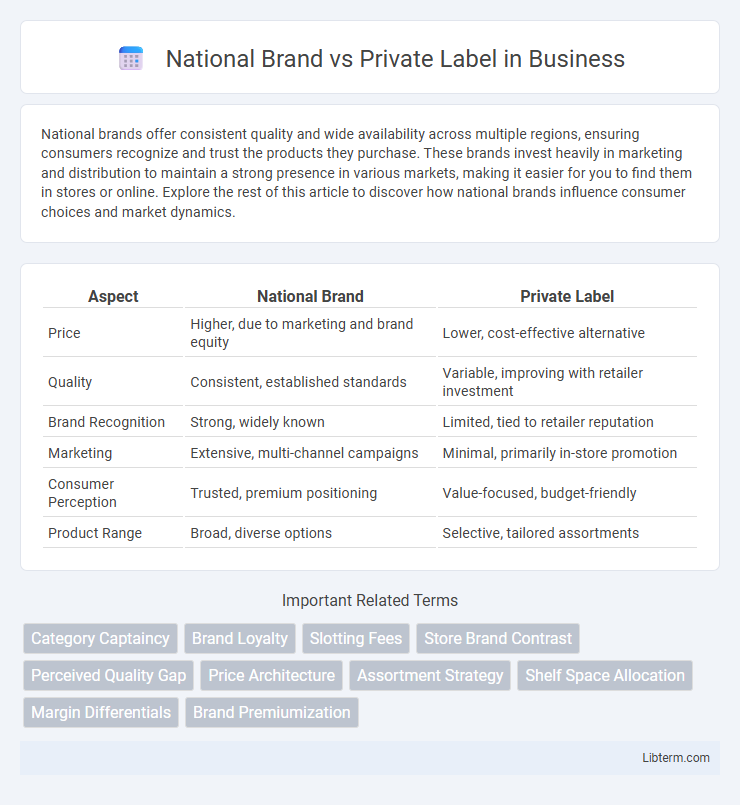National brands offer consistent quality and wide availability across multiple regions, ensuring consumers recognize and trust the products they purchase. These brands invest heavily in marketing and distribution to maintain a strong presence in various markets, making it easier for you to find them in stores or online. Explore the rest of this article to discover how national brands influence consumer choices and market dynamics.
Table of Comparison
| Aspect | National Brand | Private Label |
|---|---|---|
| Price | Higher, due to marketing and brand equity | Lower, cost-effective alternative |
| Quality | Consistent, established standards | Variable, improving with retailer investment |
| Brand Recognition | Strong, widely known | Limited, tied to retailer reputation |
| Marketing | Extensive, multi-channel campaigns | Minimal, primarily in-store promotion |
| Consumer Perception | Trusted, premium positioning | Value-focused, budget-friendly |
| Product Range | Broad, diverse options | Selective, tailored assortments |
Understanding National Brands and Private Labels
National brands are products manufactured and marketed by well-established companies, recognized for consistent quality and broad distribution, often commanding higher consumer trust and premium pricing. Private labels, also known as store brands, are products produced exclusively for retailers, offering cost-effective alternatives with increasing emphasis on quality and unique branding strategies. Understanding the competitive dynamics between national brands and private labels requires analyzing consumer preferences, price sensitivity, and retailer influence within various market segments.
Historical Evolution of Branding in Retail
National brands emerged during the early 20th century as manufacturers sought to distinguish products through consistent quality and widespread advertising, shaping consumer trust and loyalty. Private labels gained prominence in the 1970s as retailers aimed to offer cost-effective alternatives, leveraging store-specific branding to drive customer retention. The evolution reflects a strategic shift where national brands emphasize innovation and reputation, while private labels focus on value and exclusivity within retail environments.
Key Differences: National Brands vs Private Labels
National brands typically invest heavily in marketing, brand recognition, and consistent quality, resulting in widespread consumer trust and loyalty. Private labels, often owned by retailers, offer competitive pricing and exclusive products, attracting price-sensitive customers seeking value without compromising basic quality. The key differences lie in brand visibility, pricing strategies, and control over product development and distribution channels.
Consumer Perceptions and Preferences
Consumers often perceive national brands as symbols of higher quality, reliability, and brand trust due to extensive marketing and established reputations. Private label products are increasingly favored for offering comparable quality at lower prices, appealing to budget-conscious shoppers and value-seeking consumers. Preference shifts depend on factors such as product category, price sensitivity, and perceived product performance, with millennials and Gen Z showing growing openness towards private labels.
Pricing Strategies and Value Propositions
National brands typically adopt premium pricing strategies reflecting strong brand equity and perceived higher quality, creating a value proposition centered on trust, consistency, and wide distribution. Private label products often use competitive or lower pricing to attract cost-conscious consumers, emphasizing value for money and comparable quality to national brands. Retailers leverage private labels to enhance profit margins while offering differentiation through tailored product features and exclusive availability.
Product Quality and Innovation
National brands are renowned for consistent product quality and substantial investment in innovation, leveraging extensive R&D to introduce cutting-edge features and maintain consumer trust. Private labels have significantly improved quality through partnerships with reputable manufacturers, often matching or surpassing national brands at competitive pricing but with less frequent innovation cycles. The distinction lies in national brands driving market trends with pioneering product advancements, while private labels focus on value-driven quality improvements and selective innovation.
Marketing Techniques and Brand Loyalty
National brands leverage extensive advertising campaigns, celebrity endorsements, and consistent product quality to build strong brand loyalty and consumer trust. Private label brands often use competitive pricing, exclusive retail distribution, and customized packaging to attract cost-conscious shoppers and foster repeat purchases. Marketing techniques for national brands emphasize emotional connection and brand prestige, while private labels focus on value proposition and functional benefits to retain customers.
The Role of Retailers in Shaping Brand Choices
Retailers influence brand choices by strategically positioning National Brand and Private Label products to maximize shelf visibility and consumer appeal. Their control over pricing, promotions, and in-store placement directly affects consumer perception of value and quality, often elevating private labels to compete effectively with established national brands. Data analytics and customer insights enable retailers to tailor assortments, enhancing private label growth while balancing consumer trust in national brands.
Market Trends and Industry Statistics
National brands dominate approximately 60% of the global retail market, driven by strong consumer loyalty and extensive marketing efforts. Private label products have experienced a rapid growth rate of 8% annually, capturing 40% of market share due to competitive pricing and improved quality perceptions. Industry statistics reveal that private labels gained significant traction in categories like grocery and household essentials, reflecting changing consumer preferences towards value-driven purchasing.
Future Outlook: The Balance Between National Brands and Private Labels
National brands continue to leverage strong consumer loyalty and extensive marketing budgets to maintain market dominance, while private labels offer competitive pricing and increasing quality improvements to capture value-conscious shoppers. The future outlook suggests a balanced coexistence, with retailers investing in private labels to enhance profit margins and national brands innovating to differentiate through unique value propositions. Growth in e-commerce and personalized marketing will further shape the dynamic between national brands and private labels, enabling targeted consumer engagement and expanded product offerings.
National Brand Infographic

 libterm.com
libterm.com